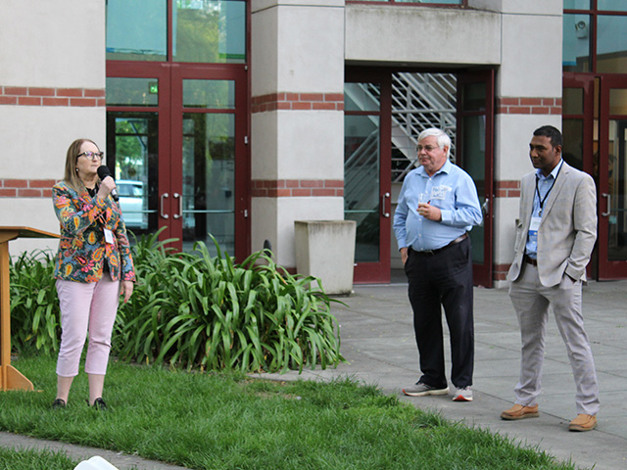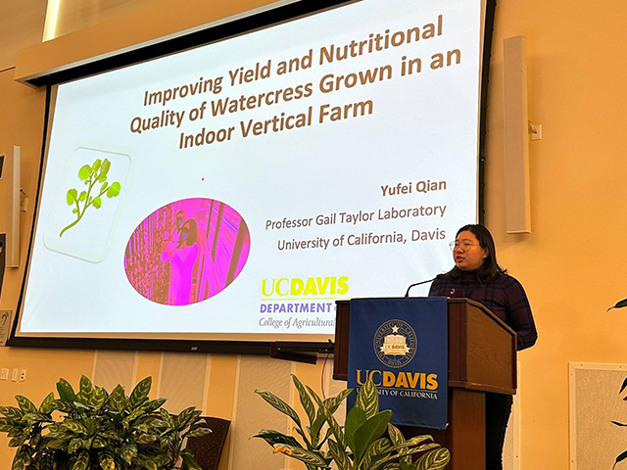These greenhouses may look purple: In some cases, controlled indoor agriculture has lettuce growing out of panels hung vertically and illuminated with red and blue LED lights instead of stretching out on horizontal tables under sunlit glass or plastic. To share the latest findings in growing food and medicine in indoor vertical and greenhouse environments, scientists from around the United States and Canada gathered recently at UC Davis, part of a working group organized through the United States Department of Agriculture. Participants are looking for more efficient ways to grow plants in spaces where factors including light, water, and nutrition can be more reliable than the weather.
Hosting the meeting were Shamim Ahamed, an assistant professor in the Controlled Environment Engineering Lab, part of the Department of Biological and Agricultural Engineering, and Department of Plant Sciences chair Gail Taylor.

Abir Ahsan, a doctoral student in the Controlled Environment Engineering Lab, discussed his work investigating “Optimized energy requirements of nursery greenhouses under Mediterranean climate.”
Yufei Qian, a doctoral student in the Department of Plant Sciences, discussed her work in the Taylor Lab with “Improving yield and nutritional quality of watercress grown in an indoor vertical farm.”
Topics during the meeting included growing crops such as watercress, lettuce, strawberries, soybeans, watermelon, foliage plants, and cannabis. Research discussed included light, radiation, carbon dioxide, water delivery, humidity, airflow, and plant nutrition. Plant growth issues discussed included reducing tip burn in lettuce and the effect of grafting on plants’ ability to create flowers.
Growing food in controlled indoor settings gives farmers power over temperature and other factors plants need to grow. Scientists are working to resolve the many problems that remain.
“Cutting-edge research for the sustainability of indoor farming is the future direction, especially the reduction of energy and an increase in new cultivars for growing indoors,” Ahamed explained.
USDA committee meets yearly to share knowledge
Heiner Lieth, a professor emeritus in the Department of Plant Sciences, welcomed guests and spoke about his work in indoor agriculture. Jason Bond, associate dean of the UC Davis College of Agricultural and Environmental Sciences, offered remarks introducing the keynote address.

Researchers offered reports on their work, including updates from NASA Ames Research Center in Mountain View, Calif., and Blue Marble Space Institute of Science, based in Seattle, Wash. Participants also toured the Core Greenhouse Facility and Central Controlled Environment Facility on the UC Davis campus.
The annual meeting, held April 19 to 21, was organized by a committee of the USDA dedicated to this area of research, the North Central Extension & Research Activity–101. The role of NCERA–101 is to help plant scientists understand how to use controlled environment technology effectively and consistently.
Source: plantsciences.ucdavis.edu
